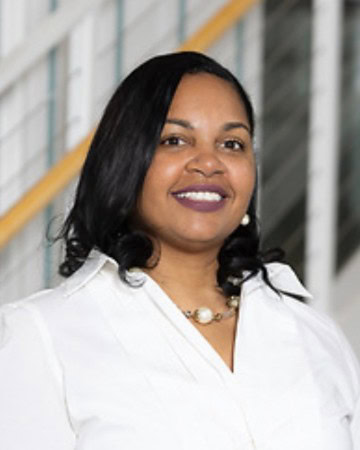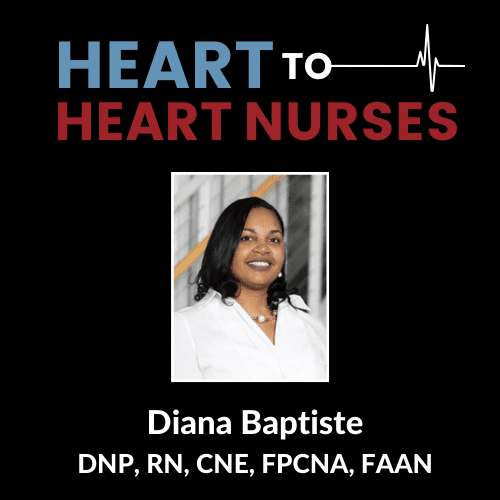Implementing Cultural Humility in Clinical Practice
Cultural humility allows health care providers to effectively communicate by understanding the complexity of the identities and experiences of our patients. Learn how cultural humility is defined, strategies for implementing it into practice to help improve interactions and patient outcomes, and health inequality factors that may impact our patients and their cardiovascular care. Our guest Diana Baptiste, DNP, RN, CNE, FPCNA, FAAN, is Assistant Professor at the Center for Cardiovascular and Chronic Care at the Johns Hopkins School of Nursing.
Episode Resources
Welcome to Heart to Heart Nurses, brought to you by the Preventive Cardiovascular Nurses Association. PCNA’s mission is to promote nurses as leaders in cardiovascular disease prevention and management.
Geralyn Warfield (host): Welcome to our audience today who will be just as excited as I am, I’m sure, to hear from our guest, Dr. Diana Baptist, and we are going to be learning today about social determinants of health. And with that, I’m going to turn it to Dr. Baptiste so she can introduce herself to our audience.
Diana Baptiste (guest): Geralyn, thank you. It’s a pleasure to be here with you today. My name is Diana Baptiste and I’ve been in registered nurse for 22 years, specializing in cardiovascular care and prevention.
I’m also an Assistant Professor at the Johns Hopkins University School of Nursing in Baltimore, Maryland. My scholarship focuses on the discipline of cardiovascular health, specifically focused on underserved populations. My work is also grounded in addressing [00:01:00] social justice issues that influence health outcomes.
Geralyn Warfield (host): Well, it’s probably not going to be any surprise to anyone that, that there is a changing landscape out there when it comes to nursing and to healthcare in general. And I’m wondering if you could address that for us?
Diana Baptiste (guest): Absolutely. My pleasure. So yeah, the healthcare landscape is definitely changing. Our patient populations look a little bit different. We’re shifting over to working with patients from various communities that we may all not be familiar with. We are now working with patients who are from refugee communities, those who identify with the LGBTQ+ community, also patients who are immigrants, patients from different ethnic minority backgrounds, so it’s really important that nurses and nurse practitioners—and all healthcare providers—really stay abreast to working with these patients and understanding how we have to shift our communication. And also, understand how DEI comes into play in the care that we provide.
Geralyn Warfield (host): Well, thank you so very much for that amazing [00:02:00] overview, Diana.
And I’m wondering if we could pivot just a little bit. Diana, would you do us the favor of speaking about cultural humility, please?
Diana Baptiste (guest): Thank you, Geralyn, absolutely. So, what is cultural humility? Cultural humility—the concept of culture humility—was first mentioned in 1998 by two physicians and they used it to guide medical education.
In this concept, they emphasize that cultural humility is more of a desirable goal than cultural competence, because it is truly impossible to master or become competent in a culture without years of immersion. So, cultural humility, it’s a more realistic and a better approach when working with diverse populations.
So, more recently, myself and a colleague from the University of Miami, Dr. Cindy Foronda and colleagues at Johns Hopkins School of Nursing, we conducted a concept analysis on the term because we wanted to learn more about how we can apply it to nursing practice. So, we [00:03:00] developed a diagram that captured the essence of the attributes and consequences of cultural humility.
And what we found is that in the world of diversity and power imbalances, cultural humility is a process that, that fosters openness, self-awareness, being egoless, and incorporating self-reflection and critique after interacting with diverse individuals. And I’ll explain that a little bit more and in the context of health and nursing care to help you understand.
But what we found is that in this concept analysis that the resulting outcomes are lifelong learning, which is necessary for cultural confidence, because we’re never truly competent in working with other cultures, it is a lifelong learning process. And the goal of that is to foster empowerment for ourselves and our patients.
And that’s the mutual benefit of developing these partnerships with our [00:04:00] patients and also to influence optimal care and respect for our patients. So that’s where we’re going with cultural humility because cultural competence pretty much just stops at, “I know about this culture. I know how to talk to them. I know how to care for them.” Where with cultural humility really guides you through those steps to gaining that mutual respect and that mutual benefit that is needed for patient care. And more so, it really works well when you’re trying to achieve shared decision-making with your patients.
So how can we practice cultural humility and our work with patients?
What we can do is just follow the steps. So, one of the steps of cultural humility is just to be open and inquisitive. And by doing, and by doing this, we’re learning from our patients. We’re learning about what’s important to them, what must be avoided in the care that we provide, and we do this so that we can honor their requests and go in with an open heart [00:05:00] and an open mind to provide quality care that aligns with their preferences, whenever possible, because really, at the end of the day, it’s about the patient, not about us, right?
Another step in cultural humility is to be self-aware. So, thinking about like, do you, are you judging your patients and their families? You know, what do you know about their backgrounds and culture, and what do you know about their culture that might influence not only how they receive care, but how they seek care? So, these are the things. So, we really want to be aware of our unconscious biases and understand that, you know, we need to take a closer look at what you know about our own thoughts and actions while we’re working with our patients.
Another step is to be aware of others. Cultural humility is a two-way street. It’s a partnership. While we need to do our part, we also need to recognize that patients or their families may be influenced deeply by their own held beliefs and biases. We want to think about historic [00:06:00] traumas, societal pressures, disenfranchisement, marginalization, you know, think about these experiences of our patients that could actually have an influence of how they speak to us, or whether they trust us or not as healthcare providers. So that’s, that awareness of ourselves and others [is] extremely important.
Other steps of cultural humility include being egoless, self-reflection, and embracing lifelong learning. So being egoless just really challenges you to expect and welcome diversity of thought and expression. We’re not always going to agree with what our patients want and where they’re not always going to agree with the, the care that we’re offering. So we’ve got to recognize that conflict is a natural part of life, especially when people are experiencing a fear of losing their lives, losing loved ones or just that loss of control.
So that, in what that does: is it creates a power imbalance. Because, [00:07:00] think about it—when you walk into an exam room and your patient’s on that exam table, or if you walk into an inpatient area and the patient’s in that patient care, in that hospital bed, they’re immediately vulnerable. Doesn’t matter what walk of life they come from. When you put a patient in a gown and on a bed or exam table, they are vulnerable, and the power imbalance begins.
We’re wearing the white coat, we’re wearing the scrubs. And so, we want to be aware of that. And we want to level the playing field with our patients and their families by giving them a voice. And so, being egoless is really helps us, that step of cultural humility helps us establish that mutual respect. And eliminate those power imbalances that happen when we care for our patients and in the clinical setting.
Self-reflection is important. We want to critically evaluate our interactions with our patients. Think about what went well, what could be improved? You know, we will make mistakes. So, we need to learn from those by [00:08:00] self-reflection. Sometimes we don’t always say the right things, but we need to take a deep breath, stop, and think about what is being said. Think about what our patients want and how we can move forward.
Embracing lifelong learning is the greatest part of cultural humility. It’s the part that I truly, truly love about using this tool, to work with patients because I’m never an expert. We’re never experts at what we do. We have to, this is why we do continuing education through the PCNA and other organizations, because we, we never reached that peak.
So, embrace lifelong learning. It’s far better to ask patients about what they want rather than just providing them with answers. I have learned the most in my own clinical experience from my patients. So, think about that, you know, and think about what they want, think about what you, what you want them to teach you, because we need to learn from them.
You know, show your patients that you value their expertise, and [00:09:00] use what you’ve learned in planning and implementing their care. So that’s pretty much what cultural humility is. It’s just following those six steps of just being aware of yourself, aware of others, being egoless, using self-reflection as a strategy to enhance your interactions with diverse populations, and then finally embracing lifelong learnings that you’ve make sure that you just never put a cap on what you have learned, a cap on how you interact with others.
Always be open to learning new, new strategies. That’s why I use cultural humility. It’s just, for me, I feel like it’s really enhanced my patient interactions. And I really encourage other nurses to look into this particular concept and see how you can use it to enhance your own care and communication with patients and families, especially because our patient populations are changing very, very rapidly. So, we really need [00:10:00] to be up to date and stay abreast to the, you know, the different evidence-based tools that’s going to help us be better nurses and better nurse practitioners.
Geralyn Warfield (host): We’ve been learning about cultural humility in the changing landscape of nursing and health care. We will be right back.
Geralyn Warfield (host): We are here with Diana Baptiste, talking about cultural humility, the changing landscape of nursing, and of healthcare.
And I’m really curious for our audience, if you wouldn’t mind, kind of narrowing down for our folks that are involved in cardiovascular care, what these kinds of topics mean to clinical care and the activities that they do in their daily lives.
Diana Baptiste (guest): Oh, most definitely. So cardiovascular care, as we know, is quite complex these days. Our patients who come in with a cardiovascular disorder typically will have multiple co-morbidities. So, the care we provide is quite complex and our approach needs to be very careful. What I find in cardiovascular [00:11:00] care, looking in the space of diversity, equity, and inclusion, is that we really need to recognize that our patients aren’t sick because of who they are.
There’s a big misconception out there across healthcare that being a certain race or ethnicity puts you at higher risk for cardiovascular disease. And so, I’m really excited that organizations like the PCNA and AHA, specifically the AHA Epi Lifestyle Council, are addressing health disparities amongst racial and ethnic minorities.
We’re finding out through the research that race alone does not account for health disparities for cardiovascular disease or cardiovascular risk factors. We’re also finding through the research that social and environmental factors actually play a deeper role in cardiovascular risk amongst all populations.
We’re recognizing that social environmental factors such as food insecurity, [00:12:00] socioeconomic status, marginalization, discrimination, and, and other stressors in life actually put our patients at higher risk for cardiovascular disease. Not so much of genetic risks or, you know, hereditary diseases.
So, looking at differences in cardiovascular risk factors, amongst social ethnic minorities is a really important responsibility that we have as healthcare providers. We don’t want to assume that because our patient belongs to a specific race or ethnic group that they’re at higher risk. We want to look at the whole picture, looking at the social determinants. Such as what we find in our research is that social determinants such as education level, socioeconomic status, food insecurity, and environment, neighborhood characteristics, environment have a greater impact rather than race, ethnicity, or genetics.
So, these are the things that we really just want to have a more holistic view as nurses [00:13:00] and thinking about those that impact. A clear example of that, that I always like to talk about with my students, is that Life’s Simple Seven, right? Life’s Simple Seven by the American Heart Association says, just do these simple seven things, right?
Exercise, you know, have a good diet, you know, control your blood sugar, your blood pressure and your stress levels and all. So, it tells you just do these seven simple things and you will reduce your cardiovascular risk, which is pretty awesome.
However, what we want to recognize as clinicians is that Life’s Simple Seven is not always simple for everyone. Eating healthy is a wonderful thing, but not so accessible for some of our patients. We do have patients who their neighborhood characteristics will have a huge impact on their access to healthy food. Just an example of that is East Baltimore, where, where I work. East Baltimore is a food desert.
So, at Hopkins, when we tell our [00:14:00] patients that “Make sure you eat fresh fish, fish, and good grains” and things like that. It may be hard for them to get those foods because, in that area where they live, if they don’t have adequate transportation to get out, to get fresh food, then they’re stuck just buying packaged food, you know, things with very like high sodium content.
And this is not—East Baltimore is just one example. This happens in many cities across the United States. So, when we are asking our patients to follow these recommendations, we also want to assess where do they live? What is their transportation? What is their access? Do they, you know, are they able to exercise?
I’ve had patients who I would say, “Well, increase your exercise, you know, get out and walk your dog.” And they’ll say, “Well, you know, I don’t live in a neighborhood,” or, “The sidewalks have a lot of cracks in them and I’m afraid to fall.” So, we really need to take a deep, deeper look at our patients and really assess what they have access to, what their environment looks like, and, and what are [00:15:00] the facilitators and the barriers for them to achieve their cardiovascular goals.
So that’s just an, just a bit of advice and just thinking about, you know, the, those factors that impact the health equities that we face, that our patients face, and that we are challenged to address with our patients.
Geralyn Warfield (host): You have given us so much great information, and I suspect people will probably want to learn more about these topics. Do you have any suggested resources for our listeners?
Diana Baptiste (guest): Oh, absolutely. Definitely continue using the resources on the PCNA website. There are many continuing education programs there.
One specifically is the new, the more recent, recently updated Patient Behavior Health Change certificate. So, there’s a couple of modules there that do incorporate the most, latest, evidence-based approaches to managing patients with cardiovascular disease, but also incorporating [00:16:00] DEI and social determinants of health. So, I really urge you to take a look at the certificate program.
Additionally, the American Heart Association is constantly, they are constantly, updating their content, to the point of where it’s really hard to keep up, but it’s a great problem to have for us. And so, I typically frequent the AHA websites and also look through the, the latest articles and state of the science documents that are published in Circulation and JAHA.
And so, for, for the most part, I think, and also the American Colleges of Cardiology will, that website will also have great up-to-date information.
Geralyn Warfield (host): On behalf of those listening to this podcast, we can’t thank you enough for [00:17:00] sharing the information that you have today. We have a lot still to learn, but we are—like all of our listeners—so engaged in making sure that our patients have the right information, that we treat our patients with care and respect that we use cultural humility in each and every interaction, and that we, as whatever age we are, wherever we are in our career, are lifelong learners and we’re committed to doing better each and every day.
With that, this is Geralyn Warfield, your host, and we will see you next time.
Thank you for listening to Heart to Heart Nurses. We invite you to visit pcna.net for clinical resources, continuing education, and much more.
Topics
- Professional Development
Published on
June 14, 2022
Listen on:

DNP, RN, CNE, FPCNA, FAAN
Related Resources
Sorry, we couldn't find any resources.






